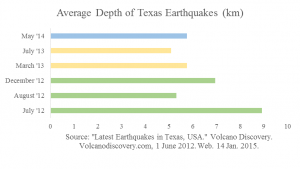Looking Under the Crust ― Seismic Activity, Fracking and Graphs
Texas has always been a battleground between skeptics and environmentalists, but a developing trend of seismic activity has also turned it into a promising research laboratory for scientists and seismologists.
Volcano Discovery, a group of scientists dedicated towards the global study of volcanoes and earthquakes alike published the following figures which the NCPA has reformatted without tampering or omissions of data:
Important disclaimers include:
- the final apparent drop in seismic activity, which may simply be due to the fact that we are only halfway into January
- an omission of point for November in 2013, for which there was no data
- However, the most important fact uncovered, is that though this chart measured the frequency of the earthquakes, further analysis of data collection methods, times and earthquake locations has led us to believe that there is significant double-counting occurring in this data… Meaning that two or three different cities may have noted the same tremor, yet the data was recorded as multiple bouts of seismic activity.
Regardless of this skew, and the likelihood for overstatement in this data, it is difficult to refute the clear trend in this chart. Indeed, the Dallas Morning News states,
There is evidence that some central and eastern North America earthquakes have been triggered or caused by human activities that have altered the stress conditions in earth’s crust sufficiently to induce faulting.
According to the Dallas Morning News, these activities include what you would expect,
… impoundment of water behind dams, injection of fluid into the earth’s crust, extraction of fluid or gas, and removal of rock in mining or quarrying operations…
But even if these tremors are truly increasing in frequency due to fracking and fuel extraction, is it really a threat to Texas’ lives and infrastructure? There is no recent record of significant damage due to tremors in Oklahoma or Texas, what’s more many of these tremors are occurring in areas where the population density can be as low as five people per square mile… denoting a very rural or sparse suburban setting.
Six months of data from Volcano Discovery’s records were randomly selected and analyzed for changes in magnitude and depth of Texas earthquakes:
Depth has decreased and magnitude has increased, however in assessing these results, we always must prioritize one of the most basic rules of statistics: Correlation is not causation. What’s more, a larger sample of months can give more definitive results. There is still much research to be done on the origin of these earthquakes, and not enough risk to human life and private/public capital given what we know, at least not enough to make drastic decisions set forth by some environmental groups.



And how about Connecticut which has no oil fracking but has just had a flurry of tremors. Could the earth just be “doing it’s thing” as it always has and always will?
BTW, thanks for the report.
Hey CRS,
Most definitely. There is much that remains that we simply don’t know. Connecticut however, does not have the sample size to draw any conclusions from it either – it’s earthquakes have been infrequent over the past few years and too small in number, even with the recent spike this past month. The spike could easily be caused by changes as arbitrary to us as convection currents in the mantle.
It is important and interesting to note however, that the state has subterranean waste-water sites and some very deep geothermal wells (the deepest of which is 1,600 feet). Though not nearly as deep as many fracking wells, they similarly utilize artificially injected water which could be changing pressure, and this is what some environmentalists claim is causing earthquakes. Connecticut government officials however have dismissed this possibility as improbable.
http://www.cbsnews.com/news/connecticut-rattled-by-12-earthquakes-in-1-week/
There is definitely more that we need to understand about this problem, natural or not! If it’s true and earthquake locations are as arbitrary as skeptics argue, it represents a grave danger to people as well as infrastructure that wasn’t built for earthquakes, especially in large cities.
Very informative and well written post.
Thank you!
I would be interested in knowing how much of this is due to the increasing number of siesmometers and their location in developed areas. The series of tiny quakes in Irving TX, e.g., at the site of the old Texas Stadium, surrounded by several major highways, near a river basin, in the middle of a prolonged drought — doesn’t appear to have much to do with oil & gas production.